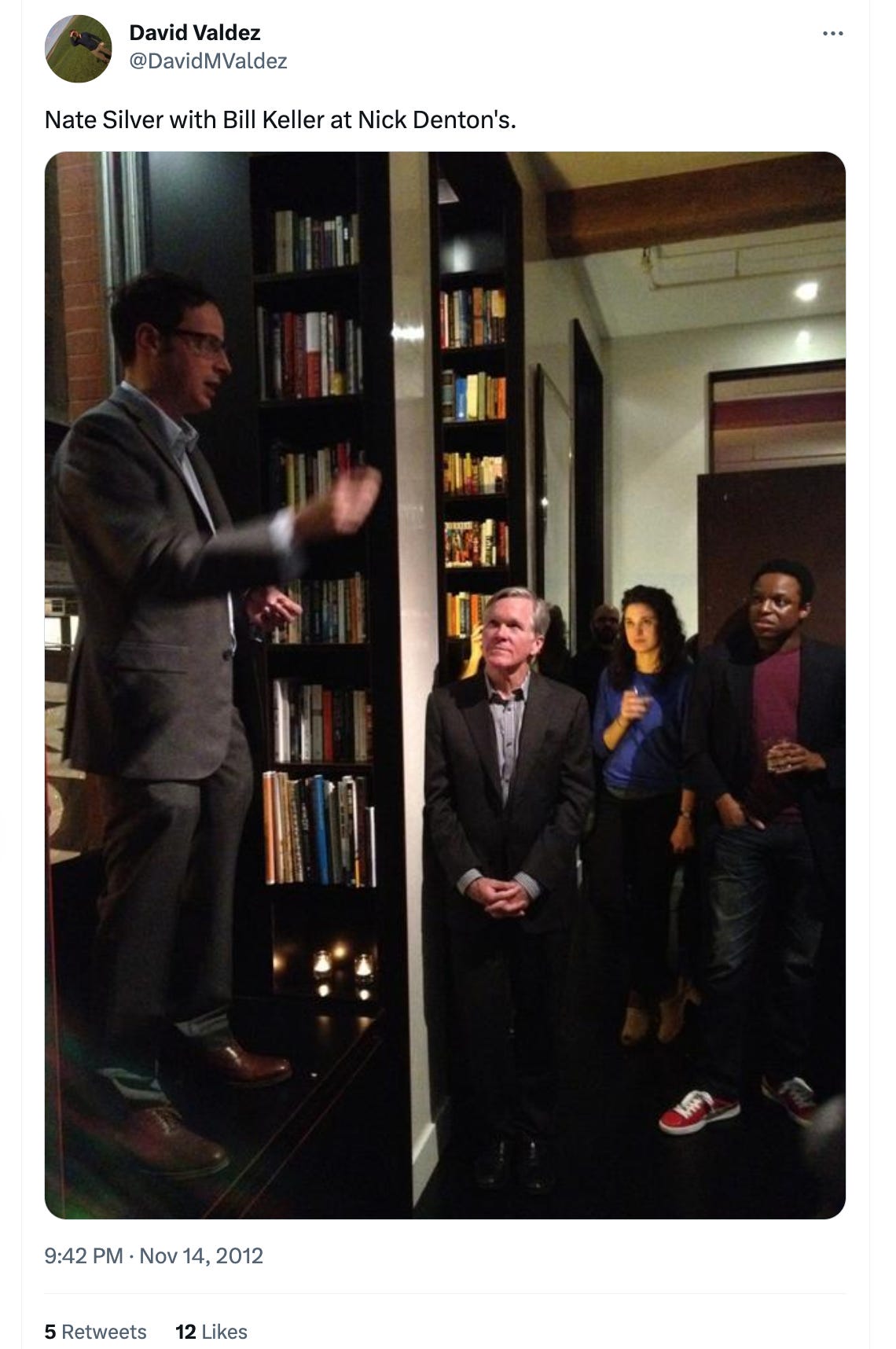Last week this tweet from the historian Quinn Slobodian popped up in my timeline:
As longtime readers know, Read Max is, in addition to being a twice-weekly subscription newsletter, one of the leading academic institutions for the study of recent nostalgia, and our research suggests that the “crystallization of the sense of the 00s” is a currently ongoing process, spearheaded by Zoomers selling clothing tagged “y2k” on DePop, to which we have contributed the following scholarly article:
The 2010s, of course, are a different matter than the 2000s. It’s much too recent to formulate a real sense of that decade qua decade; it still remains to be seen what cultural and political trends and ideas will last and how they might be transformed.
Nevertheless, as the 2010s recede into the past, certain decadal markers begin to take shape. For some reason a friend and I were recently messaging about this early (2010) Hairpin piece by Mary H.K. Choi, “All Dudes Learned How to Dress and It Sucks.” It’s a funny post, one I still remember well enough to think of as “recent.” But Mary’s description of the clothing worn by the titular well-dressed dudes is an astonishing little time capsule that gives me immediate cultural vertigo:
I’m seeing purrrrrrrfect slender micro-patterned ties with gingham shirts, the SICKEST olive M-65 parkas, shawl collared cardigans, chambray, twill, toggles, perfect-length Henley plackets, non-dickhead bowties, epaulets, and even slight club collars
“Micro-patterned ties with gingham shirts” reminded me of an aside from a Blackbird Spyplane post that similarly gestures at a 2010s that once seemed immediate and now seems frozen in amber:
Ob*ma-era “creative directors” who rocked [raw denim jeans] LIFELESSLY with, like, untucked blue-gingham shirts…
O me! O life! The powerful play goes on.
What else might we say about the 2010s? I saw Slobodian’s tweet while working on a review of Traffic, a new book about Buzzfeed and Gawker by former Buzzfeed News editor-in-chief Ben Smith. (You can read the review here at the Washington Post.) The book’s narrative starts in the early 2000s, when Buzzfeed founder Jonah Peretti and Gawker founder Nick Denton both moved to New York City, but its real focus is on the heady 2010s, when digital media start-ups were raising (and in some cases actually making) lots of money and reaching audiences in the hundreds of millions.
Smith’s book gives some shape to the decade from the perspective of the media business, if incompletely. In his review of Traffic at Slate, Dan Kois Remembers Some Websites that Smith left out:
It’s worth noting that that the two places I’ve spent the Traffic Era writing and editing, Vulture and now Slate, make zero appearances in Traffic, a book that, with a few exceptions (Ozy and Upworthy), remains intently focused on its two totems of internet media. Smith nods to the reascendancy of the New York Times in a well-reported chapter focusing on the paper’s defining 2013 innovation report, but otherwise the vast majority of websites that published for clicks over the past 20 years go unexplored: the A.V. Club, the Onion, the Awl, Hipster Runoff, Free Darko, Fire Joe Morgan, Grantland, Deadline Hollywood, TMZ, Salon, Television Without Pity, Stereogum, Videogum, the Toast, the Hairpin, Rookie, Bustle, Gothamist, all the various other -ists, Pitchfork, MP3 blogs, WorldStarHipHop, Daily Kos, FiveThirtyEight, Wonkblog, Axios, TPM, Business Insider, Yahoo News, the Daily Beast, MSN, Mic, Boing Boing, Fark, and uncountable more ranging from idiosyncratic passion project to VC-funded Future of Media.
Of the 36 sites Kois lists there (he forgot Vocativ!), I think only Slate, Daily Kos, TPM, MSN, Boing Boing, and Fark still exist under the same ownership as they did in, let’s say, 2012. The rest have been sold to larger companies, shut down, or, most commonly, sold to larger companies and then shut down.
Even the survivors are not doing particularly well. Whatever quibbles I have about the book, Smith’s publication timing has been impeccable: Last week, as the first reviews of Traffic were being published, Buzzfeed News shut down and its employees were laid off. That same day, Insider laid off 10 percent of staff and the Wall Street Journal reported that Vice, still desperately searching for a buyer, is considering shutting down its Vice World News division; on Tuesday, Disney made deep cuts at FiveThirtyEight and its founder Nate Silver announced he wouldn’t stay after his contract ended. The publication of Smith’s book, which already read like an elegy, will effectively shut the door on the decade.
What was the media industry in the 2010s? How might we crystallize a sense of the decade? The best place to start is the distribution mechanisms through which publications found readerships, and the downstream effects of that distribution on tone, voice, and coverage. For media, the 2010s began around 2008, when it became clear how much traffic could be directed to websites through the practice of search-engine optimization. Coverage was oriented towards the kinds of things people search for; the editorial tone was “robotic and overstuffed.” (Smith documents this in a chapter called “Sideboob,” after the infamous Huffpost vertical.)
But the decade really kicked into gear around 2012, when Facebook, apparently motivated by jealousy over Twitter’s popularity among journalists (and specifically the extent to which they were crediting Twitter with the Arab revolutions of 2011), opened up a fire hose of traffic to anyone willing to make their headlines sound like they’d been written by a dog, but a dog who’d been genetically/cybernetically manipulated to have the intelligence of a seventh grader, but was subsequently brain damaged in a lab accident, and was also on coke.
This peak period passed through the 2016 elections more or less unaffected until finally ending in 2018, thanks to a few trends converging. One, as Smith reports in his book, is that legacy publications (The New York Times in particular) got their act together and realized it was trivially easy to compete with (and hire from) the start-up operations that had briefly looked like they might grow into real rivals. There was no particular secret sauce to Buzzfeed or Gawker or their many peers besides being made by and for people who were comfortable being online at a moment when existing publications (and their executives) weren’t; if you could force your publication to get comfortable, and bring to bear a brand recognizable and trusted enough that people might pay for a subscription, you could move from flailing to dominant almost overnight.
The other important trend was that, after 2016, Facebook realized it didn’t want to be in the news business, because people who don’t read the news don’t like the news and people who do read the news absolutely hate the news. The firehose of traffic reduced to an intermittent trickle. At his new newsletter start-up Semafor, Smith describes the shift like this:
Peretti had built BuzzFeed into a traffic juggernaut by being among the first to see the rising social web. But BuzzFeed never found a new path when that trend turned against us — when consumers found their Facebook feeds toxic, not delightful; when platforms decided news was poison; and when Facebook, Twitter, and the rest simply stopped distributing links to websites.
By 2021, when Buzzfeed finally went public, it was clear that the scale→???→profit model was not going to work out. The 2010s are over; subscriptions are the future (for now); for advertising-based businesses, the best bet is to build reliably visited homepages like it’s 1997 again, as Max Tani suggests elsewhere on Semafor. At Slate Hillary Frey calls the decade “a detour” for journalism, which is fine as a quick and dirty metaphor but I think suggests too much that newsmedia is a powerful agent bushwacking a path to success, instead of a pathetic, sweaty interloper trying to outrun a big boulder like Indiana Jones.
Which is not to say that Buzzfeed and Gawker (or any of their many peers, rivals, and other frenemies) will be forgotten, or memory-holed as unfortunate pit-stops on the highway to a 21st century media future. But I also don’t think that Gawker will be remembered specifically for its journalistic fearlessness, or Buzzfeed for its lasting stylistic innovations. Most of the stuff about distribution and business models will be of interest only to media-studies academics. Buzzfeed and Gawker will be remembered in future movies and TV shows and novels as more than anything as symbols of a more-or-less lost decade, a privacy-flouting, social media-friendly ten years--the media equivalent of creative directors in raw denim, gingham shirts, and skinny ties.









Great piece! Weird to think I've been in this industry for this long.
One thing I'd add is the labor aspect: part of the reason all these sites became unprofitable is because they actually had to PAY people for content. Now that TikTok, YouTube, et al have figured out they can cut out the middle man of news/entertainment sites by having people do those things on their platforms for free (with the hope of one day being sponsored by an underwear company or whatever), there's no need for actual W-2 labor. :(
Great post. I tweeted this when Quinn said his thing … then I deleted it because I didn’t want to seem churlish … so now it’s going to be an over-long blog comment, which definitely isn’t a churlish medium … but how much do you think the alleged lack of recent nostalgia/“decade thinking” is due to a lack of clear names for the decades themselves? As in, it wasn’t obvious what to call the two decades from 2000 to 2020 until recently, and even then the ‘accepted’ name for each decade has changed a few times.
In America at least we’ve kept changing what we call the 2000s. During the decade itself, we called it the ‘two-thousands,’ iirc, but then after 2010, that didn’t really work anymore — it wasn’t clear if you were talking about the previous decade or the entire 21st century. So sometime later we settled on the Aughts (or just “the Bush years”) and now Zoomers also talk about y2k, I guess. Meanwhile the British call them the ‘Noughties,’ which is horrible.
Then the 2010s were unsettled too. We didn’t standardize on ‘the twenty-teens’ as a name until like 2014 or 2015, I feel like — during the few years before that, if you referred to the ‘teens,’ it wasn’t clear if you were talking about the present or the future, literally because the years 2010, 2011, 2012 did not end in ‘teen.’ (Around then, we also went from saying the names of years as ‘two-thousand-eleven’ to ‘twenty-eleven,’ too … this has been totally forgotten … I don’t have a theory about it.) So it wasn’t until 2017 or later that you could refer clearly and unambiguously to ‘the 2000s’ and ‘the 2010s.’
If this is true, then the return of the '20s would seem to decisively resolve the problem, but between Covid and US-China and everything else, 2020 is such a clear break in history anyway that there’s not gonna be a way to isolate the variable.
Last thought but I do wonder if this lack of clear '00s and '10s decadal names is a persistent trait of the English language, and not anything inherently wrong with our century. So instead countries tend to generate names for that part of the century — so you get the Regency era in the UK for the beginning of the 19th century or ‘the Era of Good Feelings’ in America. And thinking back to AP US History or whatever, didn’t it feel like the period from 1900 to 1914 was a little undifferentiated, just one big boring ‘Progressive Era,’ at least until we got to WWI, then it was 1920 and we were off to the decadal races? Anyway thanks again Max I’ll take my answer off the air.